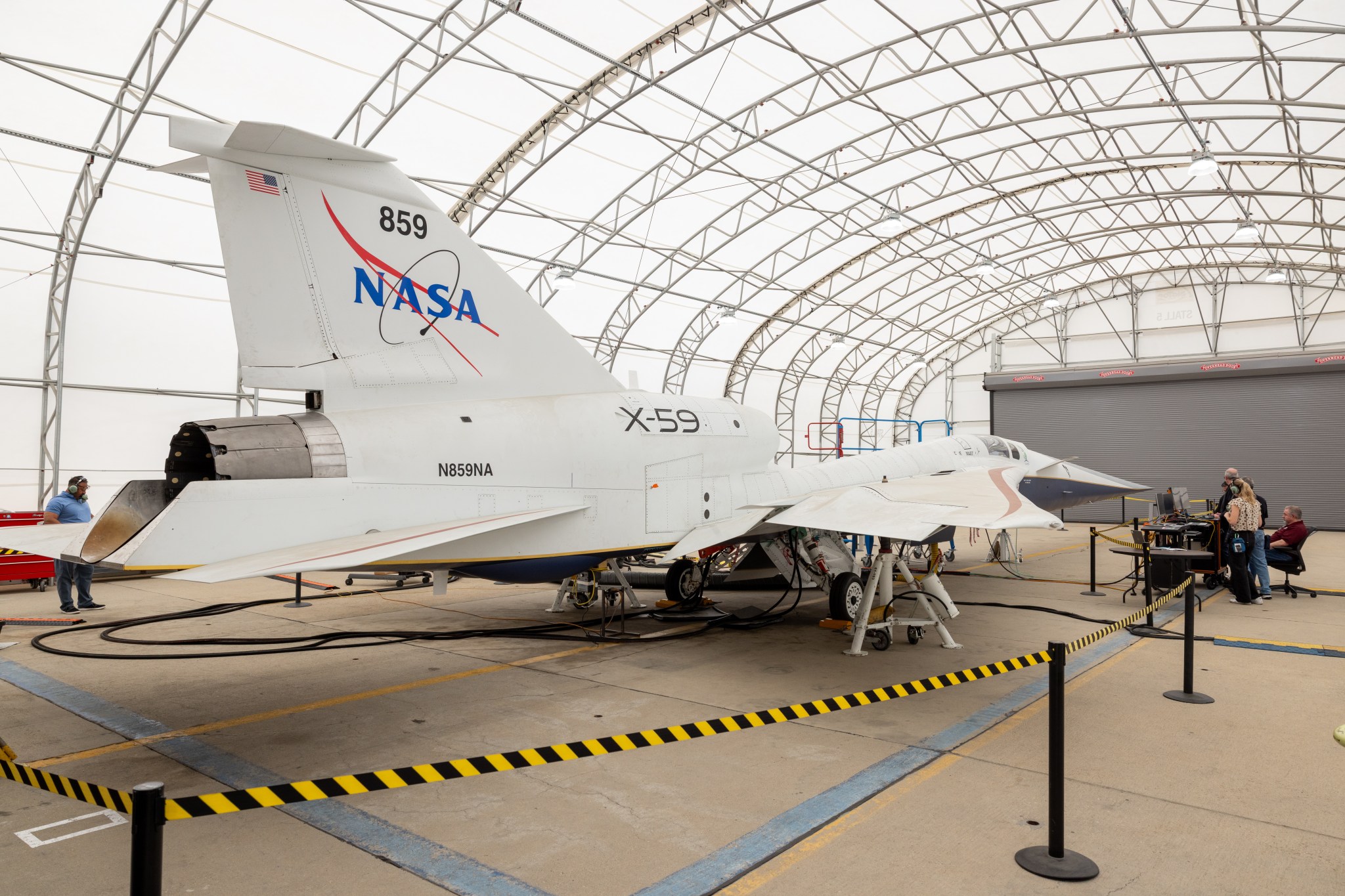NASA’s X-59 quiet supersonic research aircraft is seen during its “aluminum bird” systems testing at Lockheed Martin’s Skunk Works facility in Palmdale, California. The test verified how the aircraft’s hardware and software work together, responding to pilot inputs and handling injected system failures. Lockheed Martin/Garry Tice NASA’s X-59 quiet supersonic research aircraft successfully completed a critical series of tests in which the airplane was put through its paces for cruising high above the California desert – all without ever leaving the ground. The goal of ground-based simulation testing was to…
Read MoreTag: Aeronautics
NASA X-59’s Latest Testing Milestone: Simulating Flight from the Ground
5 min read Preparations for Next Moonwalk Simulations Underway (and Underwater) NASA’s X-59 quiet supersonic research aircraft is seen during its “aluminum bird” systems testing at Lockheed Martin’s Skunk Works facility in Palmdale, California. The test verified how the aircraft’s hardware and software work together, responding to pilot inputs and handling injected system failures. Lockheed Martin / Garry Tice NASA’s X-59 quiet supersonic research aircraft successfully completed a critical series of tests in which the airplane was put through its paces for cruising high above the California desert – all…
Read MoreNASA Selects Student Teams for Drone Hurricane Response and Cybersecurity Research
3 min read Preparations for Next Moonwalk Simulations Underway (and Underwater) Getty Images NASA has selected two more university student teams to help address real-world aviation challenges, through projects aimed at using drones for hurricane relief and improved protection of air traffic systems from cyber threats. The research awards were made through NASA’s University Student Research Challenge (USRC), which provides student-led teams with opportunities to contribute their novel ideas to advance NASA’s Aeronautics research priorities. As part of USRC, students participate in real-world aspects of innovative aeronautics research both in…
Read MoreAir Force Pilot, SkillBridge Fellow Helps NASA Research Soar
Jeremy Johnson, a research pilot and aviation safety officer, poses in front of a PC-12 aircraft inside the hangar at NASA’s Glenn Research Center in Cleveland on Thursday, April 17, 2025. Johnson flies NASA planes to support important scientific research and testing. Credit: NASA/Sara Lowthian-Hanna Jeremy Johnson laces his black, steel-toed boots and zips up his dark blue flight suit. Having just finished a pre-flight mission briefing with his team, the only thing on his mind is heading to the aircraft hangar and getting a plane in the air. As…
Read MoreNASA Supports Next Generation of Innovators
2 min read Preparations for Next Moonwalk Simulations Underway (and Underwater) Robotics teams gather on the main floor of the 2025 Aerospace Valley FIRST Robotics Competition at Eastside High School in Lancaster, California, adjusting and testing the functions of their robots, on April 3, 2025 NASA/Genaro Vavuris A group of attendees to the 2025 Aerospace Valley FIRST Robotics Competition gather outside Eastside High School’s gymnasium in Lancaster, California, to watch an F/A-18 from NASA’s Armstrong Flight Research Center, in Edwards, California, fly over the school to kick off the competition,…
Read MoreStudying Ice for the Future of Flight
NASA/Jordan Cochran Thomas Ozoroski, a researcher at NASA’s Glenn Research Center in Cleveland, takes icing accretion measurements in October 2024 as part of transonic truss-braced wing concept research. In the future, aircraft with long, thin wings supported by aerodynamic braces could help airlines save on fuel costs – but those same wings could be susceptible to ice buildup. In the historic Icing Research Tunnel at NASA Glenn, scientists and engineers are testing a concept for a transonic truss-braced wing. Their goal: to collect important data to inform the design of these…
Read MoreNASA Boosts Efficiency with Custom X-66 Flooring
2 min read Preparations for Next Moonwalk Simulations Underway (and Underwater) Eric Garza, an engineering technician in the Experimental Fabrication Shop at NASA’s Armstrong Flight Research Center in Edwards, California, cuts plywood to size for temporary floorboards for the X-66 experimental demonstrator aircraft on Aug. 26, 2024. NASA/Steve Freeman NASA designed temporary floorboards for the MD-90 aircraft to use while it is transformed into the X-66 experimental demonstrator aircraft. These floorboards will protect the original flooring and streamline the modification process. Supporting the agency’s Sustainable Flight Demonstrator project, a small…
Read MoreNASA’s X-59 Completes ‘Cruise Control’ Engine Speed Hold Test
2 min read Preparations for Next Moonwalk Simulations Underway (and Underwater) NASA’s X-59 quiet supersonic research aircraft sits on a ramp at Lockheed Martin Skunk Works in Palmdale, California, during sunset. The one-of-a-kind aircraft is powered by a General Electric F414 engine, a variant of the engines used on F/A-18 fighter jets. The engine is mounted above the fuselage to reduce the number of shockwaves that reach the ground. The X-59 is the centerpiece of NASA’s Quesst mission, which aims to demonstrate quiet supersonic flight and enable future commercial travel…
Read MoreNASA Selects Three University Teams to Participate in Flight Research
3 min read Preparations for Next Moonwalk Simulations Underway (and Underwater) NASA / Lillian Gipson NASA has selected three university teams to help solve 21st century aviation challenges that could transform the skies above our communities. As part of NASA’s University Leadership Initiative (ULI), both graduate and undergraduate students on faculty-led university teams will contribute directly to real-world flight research while gaining hands-on experience working with partners from other universities and industry. By combining faculty expertise, student innovation, and industry experience, these three teams will advance NASA’s vision for the…
Read MoreNASA Remembers Long-Time Civil Servant John Boyd
Portrait of John Boyd, whose contributions to NASA spanned more than 70 years. Credit: NASA John Boyd, known to many as Jack and whose career spanned more than seven decades in a multitude of roles across NASA as well as its predecessor, the National Advisory Committee for Aeronautics (NACA), died Feb. 20. He was 99. Born in 1925, and raised in Danville, Virginia, he was a long-time resident of Saratoga, California. Boyd is being remembered by many across the agency, including Dr. Eugene Tu, director, NASA’s Ames Research Center in…
Read More








